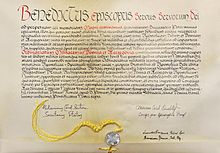Papal Bull

Papal bull or bull for short is the name for documents that proclaim important legal acts of the Pope . They were solemnly drawn up and sealed in the papal chancellery . Characteristic is the replacement of the salutatio with the formula ad perpetuam rei memoriam ("for the permanent memory of the thing").
The official Latin name of this genus of documents is litterae apostolicae , which translates as "apostolic letters", or litterae apostolicae sub plumbo , in German "apostolic letters with lead seals" or simply "apostolic seal letters" when they are translated from breven or normal litterae want to delimit. The word "bull" comes from the Latin bulla ("bubble"). The papal documents of the Middle Ages and the early modern period were regularly sealed with lead. The expression "bull" or bullae was especially popular in the 15th centuryOften used in non-official language for papal documents, which in modern diplomacy are not counted as cops in the narrower sense.
The bull, which emerged as a hybrid of the older splendor documents or "splendid bulls" called " privileges " in the technical language of diplomacy, and the litterae , had been in use since the middle of the 13th century and especially in the 15th century. In the 20th century, papal bulls were only issued very rarely, for example to bring the Code of Canon Law ( Codex Iuris Canonici ) into force in 1917 and to convene a Holy Year . Since 1740, the form of the encyclical (circular) has been chosen more frequently for educational acts by the Pope, and the Apostolic Constitution or the Motu proprio for legal acts .
The name of the bull is based on the initial words of the Arenga . Each bull begins with: < Pope's name > episcopus, servus servorum Dei ...
Controversial papal cops
On June 18, 1452, Nicholas V legitimized the slave trade with the bull Dum diversas , empowering the Portuguese king "to conquer the lands of the infidels, to drive out their inhabitants, to subjugate them and to force them into eternal servitude".
On December 5, 1484, Innocent VIII published the edict Summis desiderantes affectibus , also called the witch bull , with which the Pope asked the authorities to support two inquisitors in the witch hunt. This witch bull of the Pope paved the way into one of the darkest epochs of Europe, the witch hunt.
On July 14, 1555 issued Paul IV. The papal bull Cum nimis absurdum with which the Jews in the Papal States , which he described as Christ-killers, were instructed, among other things, to sell their property, in particular, built for them ghettos to draw certain to wear clothing identifying them as Jews, not to play, eat or fraternize with Christians, and not to engage in any trade other than collecting rags.
See also
literature
- Michael F. Feldkamp : Bulls of nuncios and legates: On the use of the term "bull" in the early modern period. In: Römische Historische Mitteilungen 34/35 (1992/1993), pp. 133–138.
- Thomas Frenz : Papal documents of the Middle Ages and the modern age (= historical basic sciences in individual presentations, volume 2). 2nd updated edition. Steiner, Stuttgart 2000, ISBN 3-515-07788-X
- Michael F. Feldkamp : "Bulls" from papal nuncios and legates? Scientific term versus contemporary language use , in: Ders .: Reichskirche und political Catholicism. Essays on church history and church legal history of the modern age (= Propylaea of the Christian Occident, Volume 3), Patrimonium-Verlag, Aachen 2019, pp. 51–55 ISBN 978-3-86417-120-8 .
Web links
Individual evidence
- ^ Gerhard Köbler: German Etymological Dictionary . 1995, p. 65; duden.de: Bulle ; The bull in the dictionary of the Brothers Grimm ; Friedrich Kluge (conception), Elmar Seebold (arrangement): Etymological dictionary of the German language . 24th, revised and expanded edition. Berlin / New York, 2001, p. 161.
- ↑ Thomas Frenz: Papal documents of the Middle Ages and modern times. 2nd updated edition. Franz Steiner Verlag, Stuttgart 2000, p. 14.
- ↑ 06/18/1452: Papal bull allows slave trade Martina Meissner, WDR, accessed on August 19, 2017.
- ^ Die Hexenjäger Deutschlandfunk, December 5, 2009, accessed on August 19, 2017.
- ↑ Text: Bull Cum Nimis Absurdum , accessed on August 19, 2017 (English).
